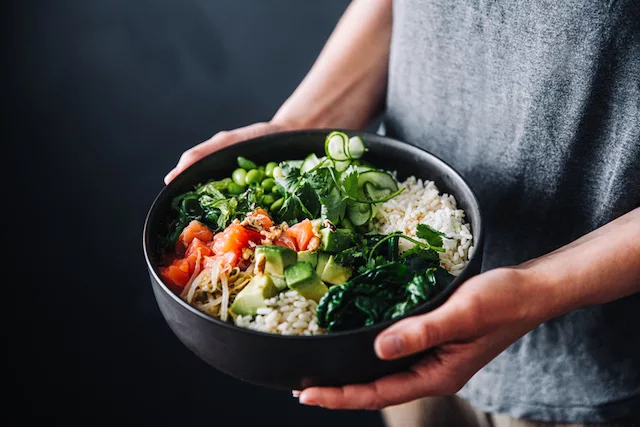All About Fiber: Soluble and Insoluble
Did you know that there are different types of fiber? Fiber is an essential component of a healthy diet, but not all fiber is created equal. Soluble and insoluble fiber are two distinct types of fiber that play a crucial role in supporting gut health, digestion, and overall well-being. Understanding the difference between these two types of fiber can help you make informed dietary choices that promote a healthier lifestyle.
This article delves into the definitions of soluble and insoluble fiber, highlights their key disparities, and provides recipes to help you increase your fiber intake.
Understanding Soluble Fiber
Soluble fiber is a type of dietary fiber that dissolves in water, forming a gel-like substance in the digestive system. This gel-like property allows soluble fiber to move slowly through the digestive tract, offering several health benefits.
Soluble fiber can help regulate the body's absorption of sugar from food, thereby aiding in preventing drastic post-meal glucose spikes. It also promotes satiety, healthy cholesterol levels, and regular bowel movements.
Various common foods are rich in soluble fiber, including:

- Apples
- Avocado
- Barley
- Beans and legumes
- Broccoli
- Chia seeds
- Citrus fruits
- Figs
- Nuts & seeds
- Pears
- Sweet potatoes
- Turnips
Understanding Insoluble Fiber
In contrast to soluble fiber, insoluble fiber does not dissolve in water or form a gel-like substance. Insoluble fiber has a coarse texture and remains intact as it passes through the digestive system. Its rough texture helps add bulk to stools, facilitating easier passage through the digestive tract and supporting regularity, healthy waste elimination, and overall digestive health.
Many foods are excellent sources of insoluble fiber, such as:
- Apple (especially the peel)
- Broccoli
- Brown rice
- Carrots
- Leafy greens
- Legumes
- Nuts and seeds: Almonds, walnuts, and sunflower seeds
- Quinoa
- Whole wheat bread
Incorporating these fiber-rich foods into your diet can help maintain optimal digestion and ensure regularity.
Soluble Fiber vs. Insoluble Fiber: Which is Better?
Many individuals question whether they should prioritize soluble fiber over insoluble fiber. The answer is both - soluble and insoluble fibers complement each other in supporting overall health. Soluble fiber dissolves in water to form a gel that aids in regulating blood sugar levels, cravings, and cholesterol levels. On the other hand, insoluble fiber adds bulk to stool, promoting digestive health through regularity.
Most adults should aim to consume between 25 and 30 grams of fiber daily. Instead of fixating on specific fiber types, strive to include a variety of fiber-rich foods in your daily meals, such as fruits, vegetables, whole grains, nuts, seeds, and legumes. Simple dietary swaps like opting for whole grains over refined options, incorporating beans and legumes, and including fruits and vegetables with every meal can have a significant impact on your overall health.
3 High-Fiber Recipes
Pumpkin Lentil Soup
Pumpkin Lentil Soup is a fiber-packed dinner option that is quick and easy to prepare. This one-pot recipe is ready in under 30 minutes.
Key features of this recipe include:
- Red lentils provide fiber to aid digestion and support stable blood sugar levels.
- Pumpkin puree adds creaminess and additional fiber to promote gut health and satiety.
For the full recipe, visit: Pumpkin Lentil Soup Recipe
Simple Quinoa Salad
A straightforward quinoa salad is a fiber-rich lunch option loaded with fresh ingredients.
Key features of this recipe include:
- Quinoa, a whole grain, offers soluble and insoluble fiber for digestive health and stable blood sugar levels.
- Fruits like avocado, blueberries, and cucumbers contribute fiber and vitamins, while avocado provides healthy fats for satiety.
- Herbs like scallions, basil, and oregano enhance flavor, making the salad nutritious and enjoyable.
For the full recipe, visit: Simple Quinoa Salad Recipe
Snickerdoodle Protein Baked Oatmeal
You can easily incorporate fiber into your favorite desserts with recipes like these delicious Snickerdoodle Protein Baked Oatmeal bars.
Key features of this recipe include:
- Rolled oats are a rich source of soluble fiber, ideal for curbing cravings.
- Ground flax and almond butter add fiber and healthy omega-3 fats to the recipe.
- HUM's Core Strength vanilla protein powder provides a bloat-free protein boost.
For the full recipe, visit: Snickerdoodle Protein Baked Oatmeal Recipe
Soluble vs. Insoluble Fiber FAQs
- What is soluble fiber? Soluble fiber dissolves in water to form a gel-like substance, aiding in regulating blood sugar levels and reducing cholesterol. It is commonly found in oats, beans, fruits, and vegetables.
- What is insoluble fiber? Insoluble fiber does not dissolve in water and helps add bulk to stool, supporting regular bowel movements. It is prevalent in whole grains, nuts, seeds, and fruit and vegetable skins.
- What are the health benefits of soluble fiber? Soluble fiber can lower cholesterol, enhance blood sugar control, and promote a feeling of fullness, assisting in weight management.
- What are the health benefits of insoluble fiber? Insoluble fiber aids digestion by preventing constipation, supporting gut health, and reducing the risk of certain digestive disorders.
- How much fiber should I consume daily? The recommended daily fiber intake is approximately 25 grams for women and 38 grams for men, but most individuals fall short of these targets. Including a variety of fiber sources in your diet is crucial to achieving a balance of soluble and insoluble fiber.
Final Thoughts on Soluble vs. Insoluble Fiber
Whether you aim for better regularity, decreased cravings, or balanced blood sugar levels, incorporating fiber into your diet can have a significant impact on your overall well-being. Enjoy the benefits of both soluble and insoluble fiber by diversifying your diet with fiber-rich foods like fruits, vegetables, whole grains, and legumes.
